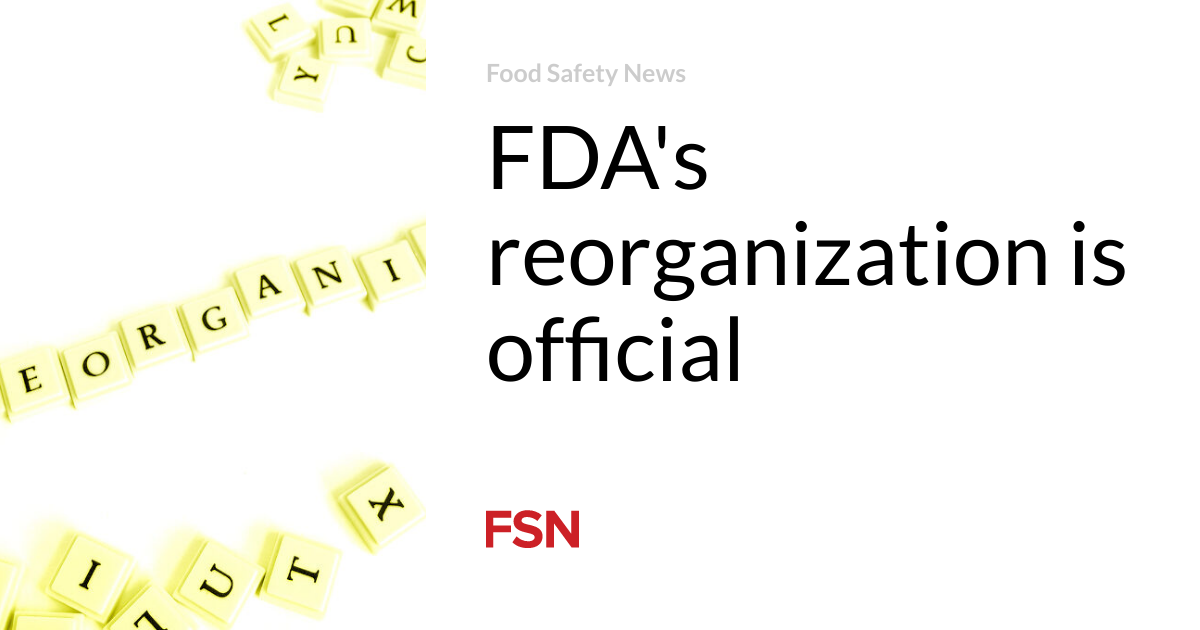Food
The FDA reorganization is official | Food safety news

Consumer Reports and the National Association of Food and Drug Officials applaud the approval of the FDA’s reorganization plan, saying the move will help ensure the nation’s food supply is safe.
“Consumers depend on the FDA to be effectively organized and governed to ensure our food is safe,” said Brian Ronholm, director of food policy at Consumer Reports, in a press release. “Today’s announcement is a major step forward, and much credit goes to (FDA) Commissioner Robert Califf for facilitating the process to get to this point.
“We recognize that there is still a significant amount of work to be done because meaningful culture change does not happen overnight. We look forward to working with the FDA to ensure this plan is effectively implemented to carry out its critical mission of protecting the public from food safety risks.”
The Association of Food and Drug Officials had similar praise for approving the reorganization efforts.
“We appreciate Commissioner Califf’s commitment to improving the FDA’s human nutrition program,” said Steven Mandernach, AFDO Executive Director. “Deputy Commissioner Jim Jones has been involved and has taken excellent steps to move the program forward. The approval of the reorganization enables a much fuller implementation of the vision of the broad community of human nutrition stakeholders. We look forward to working with the Deputy Commissioner and his team to make human food even safer in the United States.”
With the approval of the plan by the secretary of the U.S. Department of Health and Human Services, the reorganization of the Food and Drug Administration will take effect on October 1, at the start of the federal government’s budget year. The agency’s reorganization will affect almost 8,000 employees.
Problems in the structure of nutrition programs at the Food and Drug Administration came to a head during an outbreak of Cronobacter among infants in 2021 and 2022 and the subsequent infant formula crisis in 2022. That crisis caused much of the infant formula to be recalled. the United States. The factory that makes the formula was closed for months, causing even more shortages.
During a May 2022 congressional hearing, FDA Commissioner Robert Califf was questioned by members of the U.S. House of Representatives and told that he needed to make changes so that the internal communications problems exposed by the infant formula crisis would be resolved .
These communication issues revealed that the lack of a clear chain of command for the food side of the Food and Drug Administration had led to delays in identifying the Cronobacter outbreak and actions to contain it.
Following an internal review by the FDA and an external review by the Reagan-Udall Foundation, Califf appointed Jim Jones, a 30-year veteran of the Environmental Protection Agency administration, to the newly created position of FDA deputy commissioner for human nutrition. Jones has been working with a team at the FDA to reorganize the agency.
The reorganization includes the creation of new offices, the shifting of responsibilities from one office to another, and the consolidation of other programs within the FDA superstructure.
According to an FDA statement announcing final approval of the reorganization plan, the changes will “enable the FDA to be more efficient, agile, and prepared for the ever-changing and complex industries we regulate, new food and medical product technologies, as well as the consequences of globalization, climate change and other factors that require the agency to adapt quickly.”
The FDA Commissioner, Dr. Robert Califf, said the reorganization will make the agency more efficient and collaborative.
“This is a defining moment for the FDA. I am very pleased to see that after a year and a half of hard work and effort put into this transformative vision for the FDA Human Foods Program and the agency’s architecture, we are one step closer to the agency’s largest reorganization. in recent history come to life this fall,” Commissioner Califf said in the announcement.
The achievement of a unified Human Food Program will allow the agency to more effectively realize the preventive vision set out in Food Safety Modernization Actelevating the importance of nutrition, strengthening local, state and international partnerships and positioning the FDA to more effectively regulate innovative food and agricultural products, the agency’s statement said.
In addition, the agency will be better positioned to maintain the security of the country’s food supply and respond to food-related emergencies, such as the 2022 infant formula shortages.
The reorganization created the Human Foods Program by reviewing the functions of the Center for Food Safety and Applied Nutrition, the Office of Food Policy and Response, and the key functions of the Office of Regulatory Affairs (ORA) under one program.
In addition, ORA’s restructuring will allow FDA’s Field Operations Unit to focus on inspections, investigations, and imports. According to the agency’s announcement, the FDA is changing the name ORA to the Office of Inspections and Investigations (OII) to better convey the organization’s role as the FDA’s frontline.
The reorganization includes:
- Make the FDA’s Human Foods Program and Product Centers solely responsible for receiving, reviewing, and resolving consumer and whistleblower complaints, rather than dividing this role between centers and field offices.
- Renaming the Office of Regulatory Affairs (ORA) the Office of Inspections and Investigations (OII) and strengthening its role as the front line of FDA’s field-based inspection, investigation, and import operations.
- Establishment of an Office of the Chief Medical Officer (OCMO) in the Commissioner’s Office to strengthen central coordination of interagency medical issues, including special populations such as children and people with rare diseases. This includes a new Office of Public Health Preparedness and Response to support medical countermeasures policies, emergency preparedness, and coordination of medical product shortages across the agency.
- Merging the Office of Counterterrorism and Emerging Threats (OCET) and the Office of Regulatory Science and Innovation (ORSI) to form a new agency; both offices are currently housed in the FDA’s Office of the Chief Scientist (OCS). This newly merged office in OCS, envisioned as the Office of Regulatory and Emerging Science, will strengthen support for research efforts in regulatory science and preparedness.
- Creating a business transformation agency. This proposed new office in the Office of the Commissioner will collaborate across FDA to drive cross-cutting efforts to improve high-priority business processes. The proposed shift will result in a more strategic and efficient use of agencies’ resources.
- (To sign up for a free subscription to Food Safety News, click here.)













